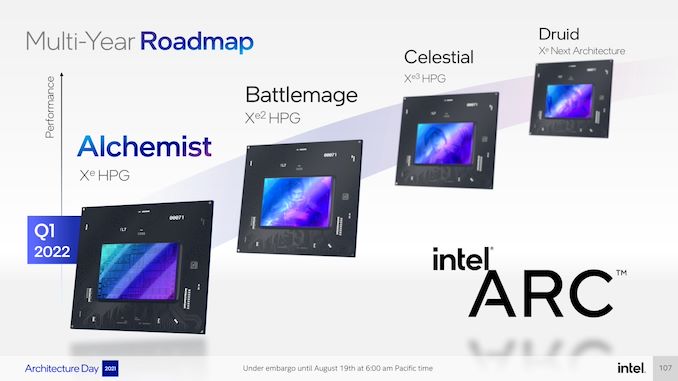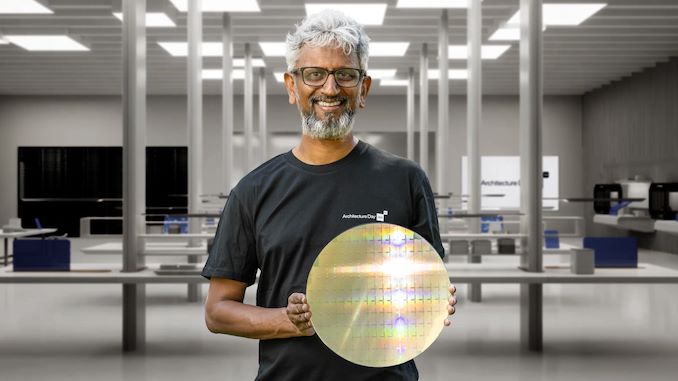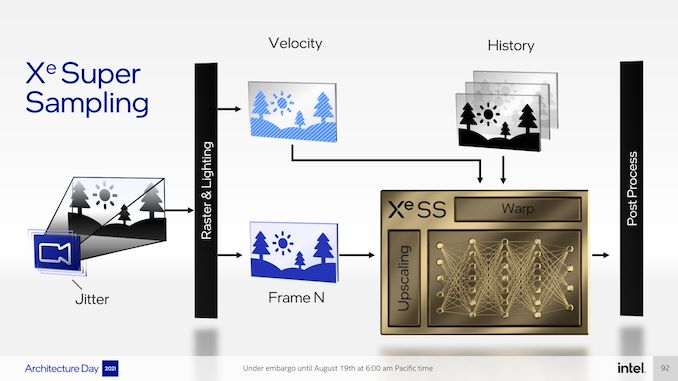Intel Reaffirms: Our Discrete GPUs Will Be On Shelves in Q1 2022
by Dr. Ian Cutress on October 21, 2021 4:16 PM EST
Today is when Intel does its third-quarter 2021 financial disclosures, and there’s one little tidbit in the earnings presentation about its upcoming new discrete GPU offerings. The earnings are usually a chance to wave the flag of innovation about what’s to come, and this time around Intel is confirming that its first-generation discrete graphics with the Xe-HPG architecture will be on shelves in Q1 2022.
Intel has slowly been disclosing the features for its discrete gaming graphics offerings. Earlier this year, the company announced the branding for its next-gen graphics, called Arc, and with that the first four generations of products: Alchemist, Battlemage, Celestial, and Druid. It’s easy to see that we’re going ABCD here. Technically at that disclosure, in August 2021, Intel did state that Alchemist will be coming in Q1, the reaffirmation of the date today in the financial disclosures indicates that they’re staying as close to this date as possible.
Intel has previously confirmed that Alchemist will be fully DirectX 12 Ultimate compliant – meaning that alongside RT, it will offer variable-rate shading, mesh shaders, and sampler feedback. This will make it comparable in core graphics features to current-generation AMD and NVIDIA hardware. Although it has taken a few years now to come to fruition, Intel has made it clear for a while now that the company has intended to become a viable third player in the discrete graphics space. Intel’s odyssey, as previous marketing efforts have dubbed it, has been driven primarily by developing the Xe family of GPU microarchitectures, as well as the GPUs based on those architectures. Xe-LP was the first out the door last year, as part of the Tiger Lake family of CPUs and the DG1 discrete GPU. Other Xe family architectures include Xe-HP for servers and Xe-HPC for supercomputers and other high-performance compute environments.
The fundamental building block of Alchemist is the Xe Core. For manufacturing, Intel is turning to TSMC’s N6 process to do it. Given Intel’s Q1’22 release timeframe, Intel’s Alchemist GPUs will almost certainly be the most advanced consumer GPUs on the market with respect to manufacturing technology. Alchemist will be going up against AMD’s Navi 2x chips built on N7, and NVIDIA’s Ampere GA10x chips built on Samsung 8LPP. That said, as AMD can attest to, there’s more to being competitive in the consumer GPU market than just having a better process node. In conjunction with the use of TSMC’s N6 process, Intel is reporting that they’ve improved both their power efficiency (performance-per-watt) and their clockspeeds at a given voltage by 50% compared to Xe-LP. Note that this is the sum total of all of their improvements – process, logic, circuit, and architecture – so it’s not clear how much of this comes from the jump to TSMC N6 from Intel 10SF, and how much comes from other optimizations.
Exactly what performance level and pricing Intel will be pitching its discrete graphics to is currently unknown. The Q1 launch window puts CES (held the first week of January) as a good spot to say something more.
















75 Comments
View All Comments
TheJian - Friday, October 22, 2021 - link
6.8B net massively up from last Q and YoY. They are best at making INCOME, even in tough times, while eventually winning either way.. Net income is needed to do that, and that is what Intel does well. You have options as the guy making piles of net income, such as buying the other guys needed wafers. Buy every wafer you can that AMD/NV/Apple need on the best nodes and make a mint on them. Gpus at worst if you can't sell enough to use all the wafers on server/hedt. It's easy for Intel to waste tons of wafers and still make money on them while severely limiting AMD/NV etc.Do it until you take their gpu income to zero, while recovering cpu. Mess with apples launches as much as you can also while doing it of course, with the intent of bankrupting both amd/nv or buying them, then ruining TSMC/apple. Just write bigger checks and get it done. As long as you're profiting while limiting their ability to produce (or make NET income) you win. Pat appears to be doing just that. Good work. Intel is run by brains now, not marketing BS. AMD has already lost IMHO, but NV/apple and TSMC a bit more tricky perhaps. You have to Kill AMD/NV (as much as possible that is, kill their income) just as TSMC is ramping up all the new fabs. Then see if TSMC can replace two large customers just as new fabs are needing customers and Intel is fabbing as much as possible for others too. Any TSMC customer you can't destroy, steal. :) Business is war ;)
Qasar - Friday, October 22, 2021 - link
blah blah blah i love intel.. intel is the best.. blah blah blahmore bs rambles from the jian... * yawn *
t.s - Friday, October 22, 2021 - link
His point is solid. Almost all who follow CPU tech news with half a brain know about this.Qasar - Friday, October 22, 2021 - link
you obviously have not seen his other posts. solid or not.. it just anothet anti amd rantname99 - Friday, October 22, 2021 - link
No. His point boils down to "TODAY most of the buyers of Intel don't have good alternatives".That's true, but the point of everyone else is that that is not a consequence of Intel's actions but of history.
- It certainly seems likely that ever more of the data center business will move to ARM. Graviton1 was just sad -- but helped AMZ learn. Graviton2 is good enough to match Intel for many workloads, even though it's still just not very good. Graviton3 powered by N2 should be very scary to Intel.
Meanwhile if you're not AMZ or an AWS user, we have Alibaba doing their thing. We have mutterings and rumors about MS, Google, Facebook going down the Alibaba path. We have Ampere there if you just want to buy a chip.
- How large can Apple grow in the laptop/PC space? Of course there are people who will never buy an Apple PC/laptop for whatever reason, and there are "technical" use cases (controlling signage, PC's used in labs, specialty medical progams, etc) that Apple has no interest in.
But for the generic user who just doesn't care much? Yes, Apple are expensive today (or, more precisely, they do not sell anything at the lowest end). Will that always be the case? Consider how (once they had total control) they grew the iPhone and iPad prices ranges from the lowest end (two year old iPhone, and iPad using two year old chips) to the highest end Pro versions. Why couldn't, and wouldn't, they do that with Macs? I remember the days were Macs were 3 to 5% of PCs. Now they are about 16% in the US. Already that's a non-neglible hit to INTC, but I see no intrinsic reason that couldn't grow to maybe 30% or more, and to grow in other countries.
Right now Apple are kinda letting Asahi Linux do their thing, but they aren't stopping them, and they have explicitly said that it's MS' choice whether they want to put Windows on Macs. When they care, they could push on both those markets -- work to "encourage" MS, work to help Linux if they need help (cf their recent Blender work). Right now they don't need to do that, and they are probably happy to have more flexibility to change things substantially over the next few years as they find their way. But in five years?
Even those technical markets... Used to be that if a PC was being used as a cash register, it was a Wintel PC. Now it's most likely to be some sort of iPad (or even iPhone) using Square or something similar. Things change...
I'm old enough to remember five years ago, when wise experienced people told me it was simply stupid to imagine that Apple could maintain their CPU performance growth to ever hit desktop levels. And those same wise experience people told me that ARM was delusional with their projections of starting to move into the data center seriously in 2020.
You can look at those past projections and insist on trivial details like "oh, ARM was off by two years".
Or you can look at those past projections, look at today, appreciate how much things have changed, and ask why the trajectory going forward will be different.
We know the ARM trajectory, we know what they plan going forward, those of us who *actually* understand something of the technology know they track they are on (both as ARM and as Apple). Meanwhile the Intel trajectory remains more of the same -- extravagant promises, gorgeous slides, followed by sad disillusion as each new product is actually benchmarked.
[ Yes yes, we know, that all changes with Alder Lake (or maybe Meteor Lake, or maybe the change happens with Raptor Lake?) ]
That's the point, that's what the sellers are seeing. Stronger competition for Intel (and x86) than ever before, along with no especially compelling response by Intel.
It will take years, yes, but let's check again in 2025...
Spunjji - Monday, October 25, 2021 - link
The point about the technical market is a good one - I think a lot of commentators on tech sites don't fully appreciate the extent to which Apple have been building themselves a market from unexpected directions. Use of iPads as PoS is something I'd have never predicted, but you see them all over the place in businesses both large and small.The release of a lower-end cut-price MacBook based on leftover M1 chips (or some derivative) a year or two from now also seems like a strong likelihood.
melgross - Friday, October 22, 2021 - link
True.Spunjji - Monday, October 25, 2021 - link
It's really not. A larger company buying itself out of trouble isn't a penetrating insight, and "business is war" is a puerile take. Intel currently being large and having the financial clout to weather a storm isn't a definitive indicator of future success (see: IBM), the idea of them being able to bully Apple out of the market by overpaying for wafers is laughable, and the idea that TSMC will collaborate with Intel to destroy most of its own customers is even more absurd.TheJian just likes to say silly things with an unwarranted air of confidence. It's his Thing.
michael2k - Saturday, October 23, 2021 - link
You realize Apple is already doing this right? Apple’s revenue last quarter was $83b, which dwarf’s Intel’s revenue.Apple is already locking customers out of TSMC’s best process nodes and Intel has been stated as wanting Apple’s business as a foundry; which implies they don’t have enough business on their own to lock out Apple, let alone Apple and NVIDA and AMD
Spunjji - Monday, October 25, 2021 - link
You have the attitude of a child.